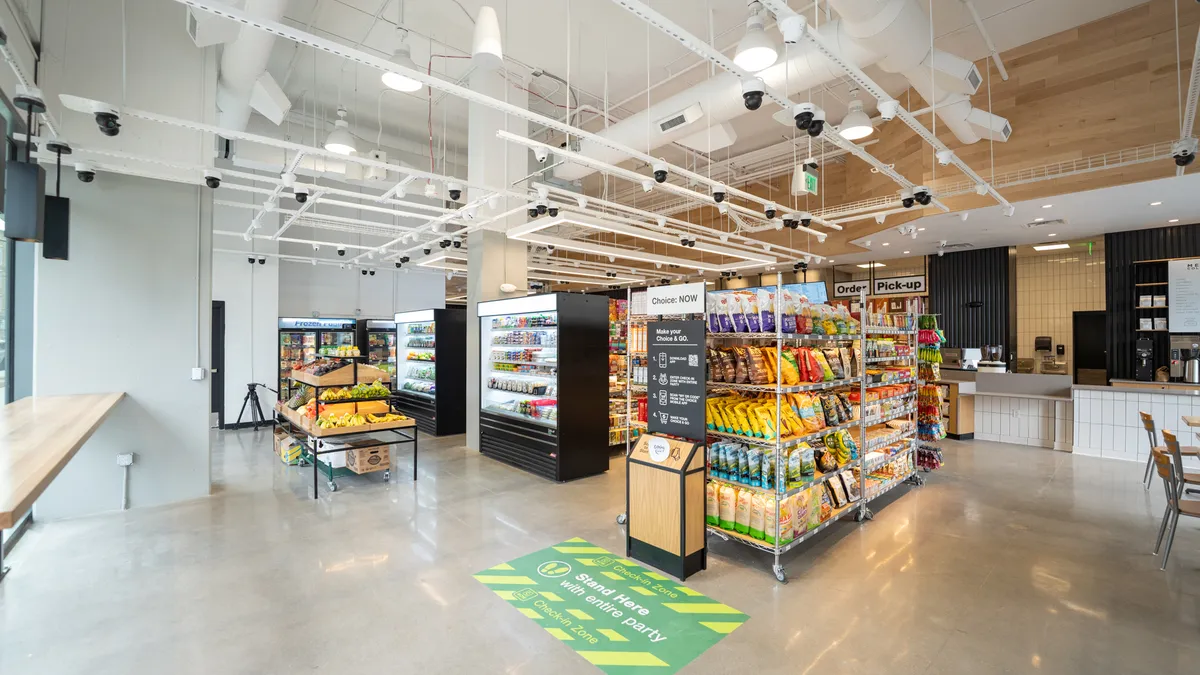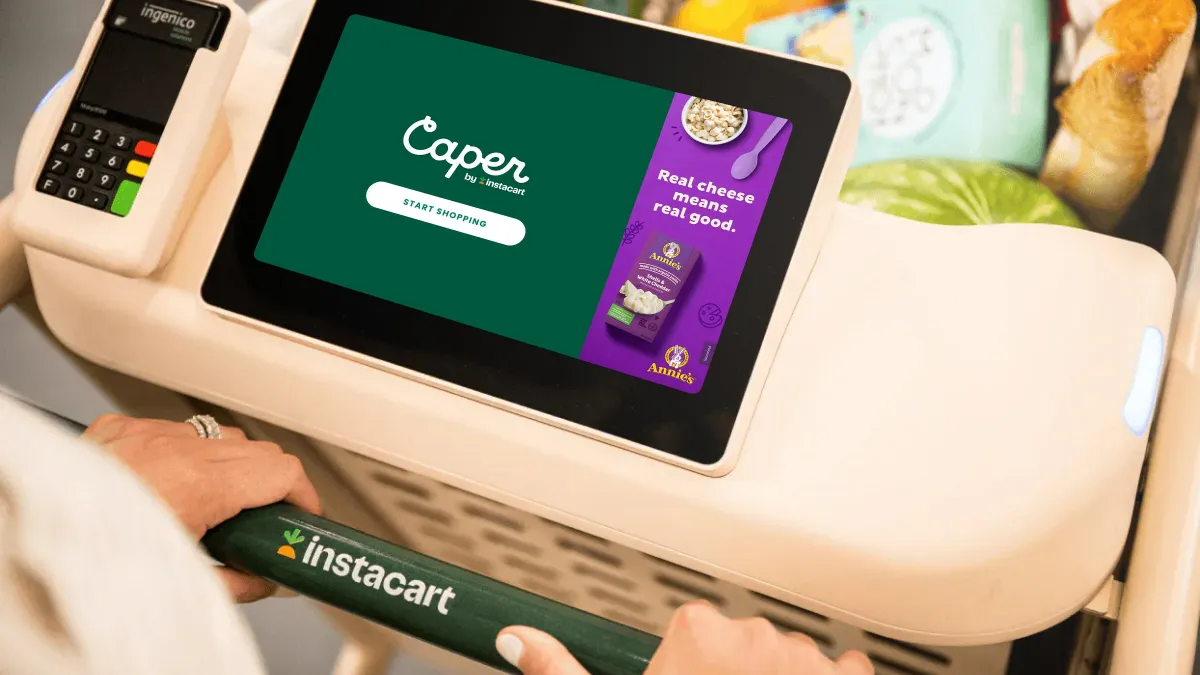From its grocery-convenience hybrid model to its rollout of autonomous kiosks and electric charging stations, Choice Market has embraced new retail concepts as foundational parts of its growing business.
Now add frictionless shopping to that list. On Friday, the Denver-based company went live with its computer-vision array inside its recently opened 5,000-square-foot flagship store at 939 Bannock Street in Denver. Developed in partnership with technology firm AiFi, which has also developed checkout-free shopping experiences for Ahold Delhaize, the system checks shoppers in using a unique QR code, tracks them as they walk through the store selecting items and sends a receipt once they leave.
Mike Fogarty, Choice’s founder and CEO, said that Choice: Now, as the new frictionless experience is being branded, will be installed in the company’s three other stores as well as all future stores the company builds. Stores will also offer self-checkout and a staffed checkout for consumers that want a more familiar front-end experience.
“The thesis of why we built this technology was to increase basket size, increase repeat purchases and boost loyalty with our customers,” Fogarty said.
Choice Bannock is the company’s largest store to date and sits on the bottom floor of a 350-unit luxury apartment development in Denver’s Golden Triangle neighborhood. It features its largest grocery assortment and is the first store to have a hand-dipped ice cream station. The store also carries products and services available at other locations, including fresh made-to-order meals and a curated selection of specialty and conventional goods, including many from local producers.
Here’s a look inside Choice Market’s fourth store.
Offering different customer 'journeys'
To begin the frictionless shopping experience — what Fogarty calls “the happy path” through the store — customers must first stand inside a green “check-in” zone, then scan a QR code generated through the Choice Market app. That process identifies the paying shopper and everyone else in their party, allowing them to roam the store, pick out products and then leave, with all of their selections added to the single payment point.
Fogarty along with Chief Brand Officer Darcy Rae Johnson and Chief Operating Officer Ben Kipfer described different “journeys” through the new store. Shoppers can order a meal ahead of time and also gather some groceries via the checkout-free option on their way out. They could order a meal and a smoothie at the foodservice station and pay at the kiosk at the back of the store, or shop the grocery selection and use a front-end kiosk. Or they could gather everything and pay via the front-end register.
Fogarty said in addition to offering a new experience for shoppers, the frictionless system delivers business intelligence that Choice can use to hone its operations and better understand customers.
“What's cool about this tech is effectively everything becomes a commerce transaction," he said. "They check in the store, and at that point we know who this customer is, and the power of that data is really indescribable.”
Made-to-order meals, coffee and ice cream
Like other Choice Market locations, the new store features made-to-order meals and smoothies, with an emphasis on healthy and inventive selections like bowls, salads and flatbreads. There’s also a coffee bar operated by Method Coffee Roasters and a hand-dipped ice cream station. The store also has a small seating section.
For now, shoppers using the store’s frictionless shopping path need to pay separately for their foodservice, coffee and ice cream purchases using the kiosk. Fogarty said he plans to fully integrate the department into the computer-vision system.
“Right so it's two steps, but eventually we want to get to one where it's integrated.”
A larger grocery selection
Choice Bannock has around 20% more grocery items than its other locations — a reflection of the higher concentration of residential developments nearby, Fogarty said. The store carries organic produce, grab-and-go food and beverages, pantry staples, snacks and alcoholic beverages, with an emphasis on specialty and local brands.
Fogarty said produce and frozen meals have been standout categories for Choice over the past year. The new store has around 60 organic fruits and vegetables and five doors of frozen foods.
Evolving e-commerce
More than a year into the pandemic, Choice continues to see more e-commerce users and higher digital baskets each month. The company currently charges $3.99 for delivery and utilizes an electric-vehicle fleet based out of its Colfax Avenue store, which has charging stations. Choice also offers no-fee pickup on groceries and meals from stores, with most foodservice orders available in 10 to 15 minutes.
“We want to really bring users into the ecosystem," Fogarty said.
In addition to its own e-commerce platform, Choice also lists its assortment on Uber Eats and DoorDash. Kipfer said that in addition to a good marketing opportunity, these platforms let Choice use their own delivery fleet on orders, if they choose — something they’ll typically do for larger orders.
“That saves us a good amount of money on the transaction fees and also just continues to get our brand out there,” he said.
New frontiers ahead
Fogarty and his team said there are a few additional innovations they hope to introduce to Choice Bannock in the near future. Shoppers buying alcohol currently have to check in with a store associate, but Fogarty said he’s researching automated locks that would open when an age-appropriate customer scans their QR code. Given the store’s location on the ground floor of a residential building, Choice could eventually offer concierge delivery to apartments when consumers aren’t home as well as 24-hour store availability, with shoppers able to enter and pay via the computer-vision system.
Across Choice’s small but growing footprint, Fogarty hopes to eventually offer delivery from every store using driverless vehicles. He and the team are also exploring retail media, a new e-commerce fee structure and more.
Fogarty said Choice will likely move into a new city sometime in the next year or two, with a long-term goal of opening 40 to 50 units across several markets in the next five years.
“We see a massive opportunity to create a convenient, small format grocer across the western U.S. and eventually across the whole country," he said.





















